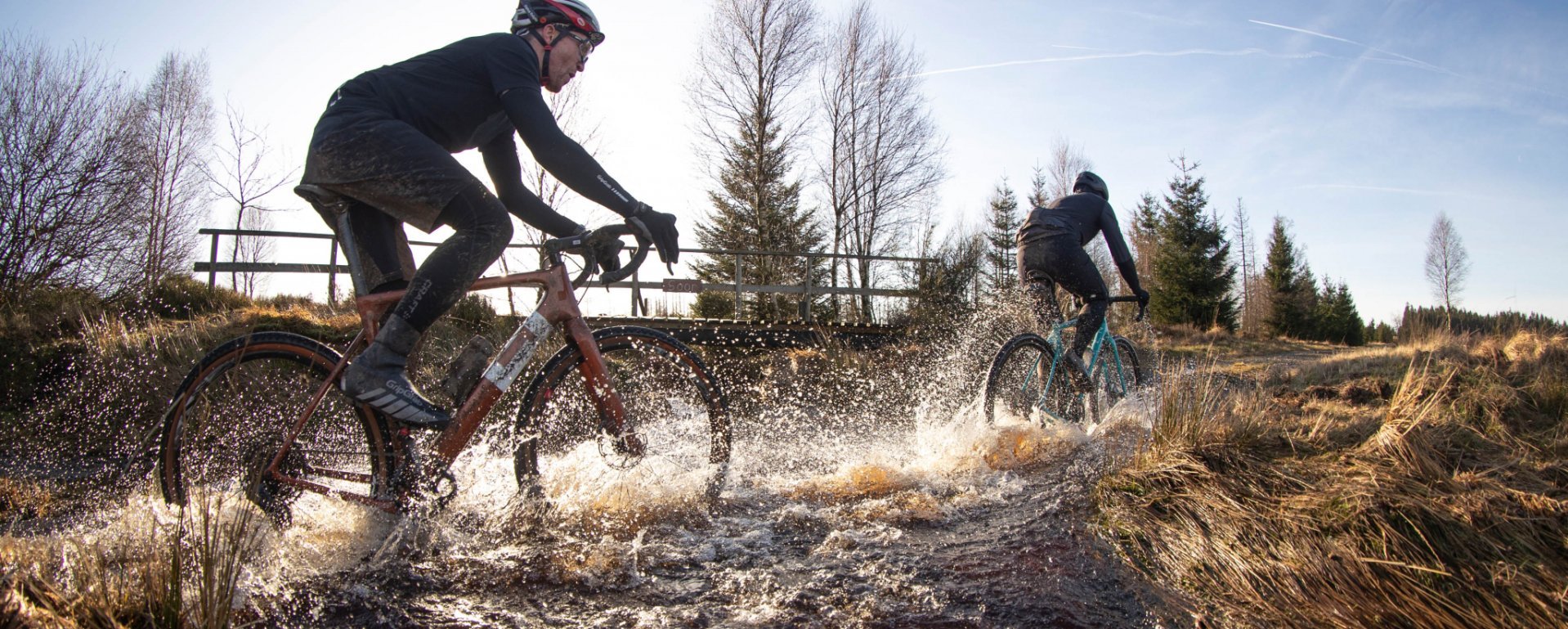
Bicycle inner tubes for road bikes or MTBs: Wha...
Bicycle tube or tubeless tyre? Butyl, TPU or latex? Find out which system is best for you and your bike here.
A gravel wheelset has to withstand a lot of hard use. Can't find the right one? Build it yourself! We’ve put together some tips to help you get started.
Gravel bikes are the trend of the moment. The relatively new genre combines the off-road capability and versatility of a cross-country hardtail with the straightforwardness, speed and aerodynamics of a road bike to create a whole new riding experience. Whether you’re pedalling at top speed over gravel, taking epic tours on pothole-strewn back roads, going on excursions into light terrain, bikepacking or making your commute more dynamic: the gravel bike is a real all-rounder. A custom wheelset can further enhance your overall riding experience. Depending on your what you’re looking for, you can use MTB or road bike components – or rely on the growing number of gravel-specific components. If you’ve got questions, we’ll show you what to look out for.
Despite the growing number of pure gravel wheelsets from reputable manufacturers, there can be many reasons to build a custom wheelset. Many bikers simply enjoy picking out every single part on their dream bike themselves. More technically speaking, DIY can have its advantages, especially for outside-of-the-box thinkers with specific preferences. After all, hardly any component influences a bike’s handling as significantly as the wheels.
Among enthusiasts for every bike tyre width, it has long been frowned upon to mix different categories from the same manufacturer. Adherence to a specific make/model was the gold standard, whether Dura Ace or XX1. Mixing road bike and MTB components has caused many headaches and compatibility problems for bikers and disapproval among cohorts. However, you should not put such limits on yourself when building a gravel wheel. With a clever mix of MTB, road and gravel components, you can achieve exactly the characteristics you want. Curiously, this type of combination is often referred to as "mullet" (such as the combination of a 29 inch front wheel and 27.5 inch rear wheel on an MTB), for example when you combine the crank, brakes and shifters of a SRAM Force with an SRAM Eagle MTB cassette. The term seems to be becoming synonymous with “grab bag".
In the gravel world, there are three extremes and everything in between: 1. The roadie, who has no patience for honking cars and manoeuvring on badly-paved side roads, but who otherwise treats their gravel bike like a road bike. 2. The mountain biker who gets more enjoyment out of easier trails and forest-to-highway transitions with a gravel bike. 3. The adventurer who racks up mile after mile in the remotest corners of the world.
It is clear that no one wheelset shines equally in all fields. For example, do you want to ride root trails with your gravel bike? Then your custom wheel won't likely break any weight or aerodynamic records. As always, it is important to think carefully about what you are willing and not willing to compromise on beforehand.
The most important question you will probably face concerns wheel size. Many modern gravel bikes allow the use of 650B and 700C wheels. 650B corresponds to 27.5 inches in the mountain bike world for use with tyres with an ETRTO of 584 millimetres. The classic road bike size 700C corresponds to 28 inches in the road world, or 29 inches in the mountain bike world, for use with tyres with an ETRTO of 622 millimetres. Smaller wheels are more agile and often allow for the installation of wider tyres – which can be advantageous for more than just off-road use. To an extent, however, you are also largely dependent on the use of MTB or gravel rims. Road bike components in 650B are scarce, but it’s a different story with their bigger siblings. Here you can help yourself to products from the (29 inch) mountain bike shelf as well as from the (700C/28 inch) road bike range – despite the discrepancies in labelling, the sizes are identical. Bigger wheels roll better and can maintain speed. However, tyre clearance is lower on many frames with this dimension, and larger wheels are often heavier or flex more than their smaller siblings. What’s exciting, though, is if your bike allows the use of both wheel sizes right out of the box, you can radically alter its character with a second or new wheelset long after purchase. With slightly-smaller wheels, for example, the bottom bracket of the bike is moved slightly downwards, which improves cornering but reduces ground clearance off-road.
| Rim diameter or ETRTO | French designation | Inch designation(s) |
| 584 Millimetre | 650B | 27.5 inch |
| 622 Millimetre | 700C | 28 inch, 29 inch |
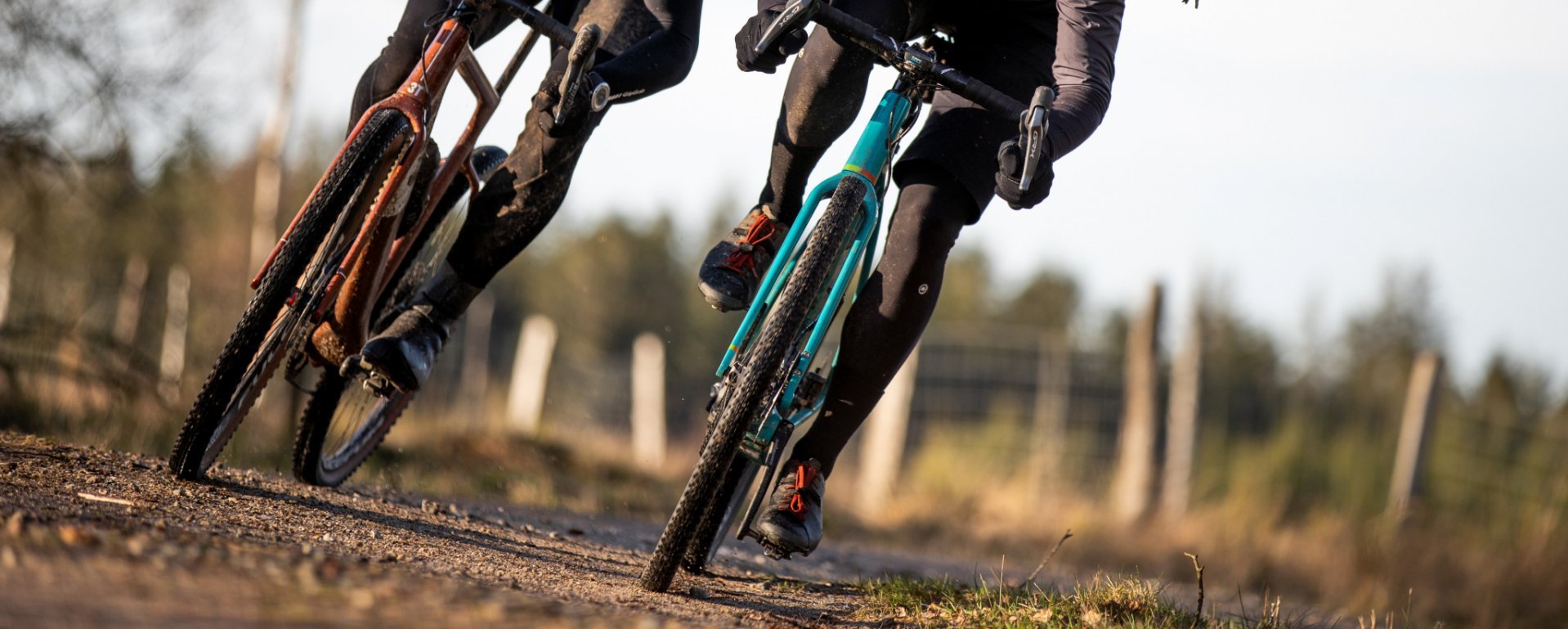
Maximum tyre clearance is one of the most important features of a gravel bike. Road-oriented bikes usually have a factory-standard tyre width measuring between 30 and 40 millimetres. This promises aerodynamic advantages, but limits shock absorption and grip, and thus the level of off-road capability. For this reason, substantially more voluminous tyres – sometimes measuring over 50 millimetres wide – fit more often on off-road gravel bikes. In the mountain bike world, you'd go with 2.0 inches or more. For your custom gravel wheelset, you should first determine your approximate desired tyre width. Why? There are two simple relationships between the inside width of the rim (also called the jaw width) and the width of the tyre. Firstly, the same tyre has a greater volume and a greater actual width on a wider rim. Secondly, the larger the jaw width while maintaining the same tyre width, the more "angular" the shape of the tyre on the rim; the smaller the jaw width, the more "rounded". This makes sense because on a wider rim, the tyre bed rests on a wider base.
Not every tyre width works harmoniously with every rim. To put it simply, the wider the tyre, the wider the rim should be. However, there are limits. If you mount a 2.1 inch tyre (54 millimetres), which is narrow in the MTB world but bulky on a gravel bike, on a 35 millimetre-wide enduro rim, you get a very "angular" tyre shape. However, because gravel tyres usually do not have pronounced shoulder lugs, this results in a narrow border area and a hard transition from tread to shoulder when cornering. In a worst-case scenario, the tyre will abruptly slip off. Conversely, the same 2.1-incher gets very little support from the rim flange on a narrow 17-millimetre road wheel rim. At low pressures and high forces, it can pull it cleanly off the rim in extreme cases, which among mountain bikers is referred to as "burping."
Below you’ll find rim-tyre combinations as recommended by ETRTO. In general, there is a trend towards wider rims, as these offer advantages in terms of tubeless riding and aerodynamics. However, approvals from rim and tyre manufacturers must always be taken into account when using them.
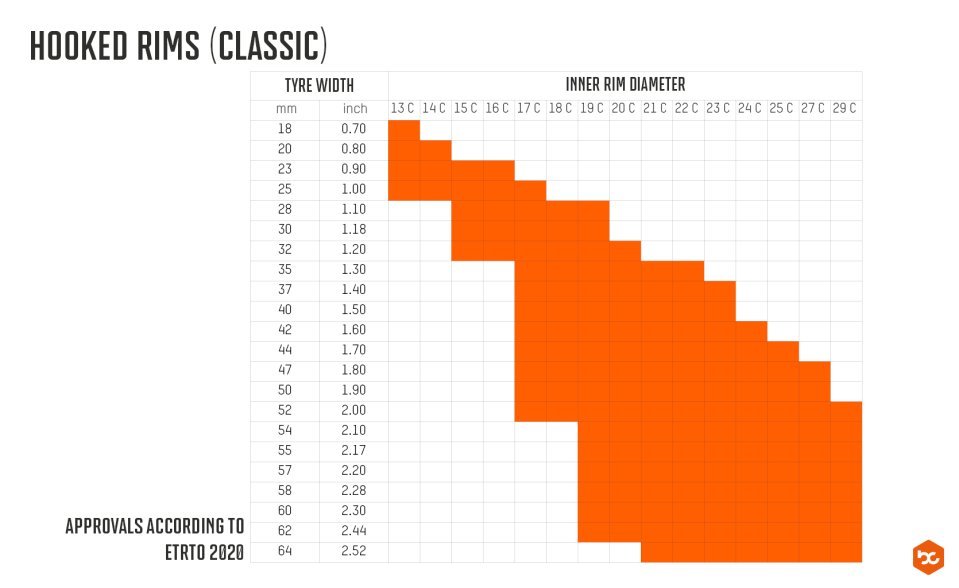
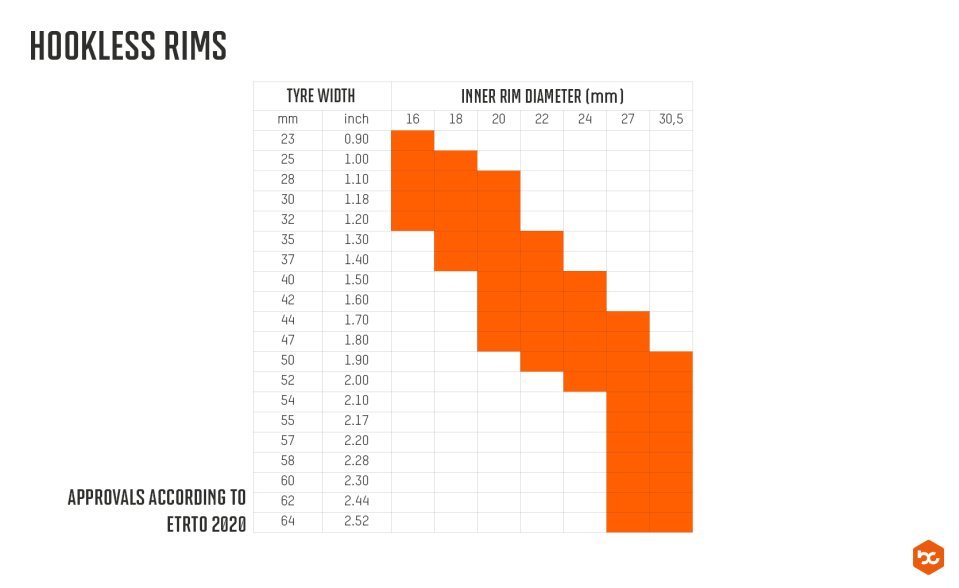
In addition to rim width, rim height is an important criterion for gravel bikes. Depending on the front end of the bike and the cyclist, at the latest from a riding speed of approx. 15 km/h, the air resistance is higher than the rolling resistance. The faster you go, the wider the gap opens, as air resistance increases exponentially with speed while running and rolling resistance increase only very moderately. There are also good reasons to use aerodynamic high-profile rims used on road bikes with gravel bikes. However, since aero components are not usually combined with wide tyres (which would be counter-intuitive, since a wide tyre increases drag appreciably), a high-profile rim somewhat limits the choice in rim width. On the other hand, there are no restrictions in terms of choosing materials. No matter if you’re using products off the MTB, road or gravel rack, in principle you can put together every desired characteristic with aluminium as well as with carbon rims, even if not always in combination. Carbon rims allow for lighter wheels with the same degree of stiffness, or are generally stiffer than wheels with aluminium rims for the same weight. Aluminium is less expensive and more forgiving of minor damages such as dents.
Gravel bikes are available – depending on the basic demands, see above – with different dimensions for hub widths and axle diameters. However, classic nine-millimetre quick-release axles in hubs with 100 or 135 millimetres over locknut dimension have become rare. Stiffer thru-axles with mostly twelve millimetre diameters in 100 or 142 mm hubs dominate the market. Off-road gravel bikes sometimes use Boost components with over locknut dimensions of 110 or 148 mm and axle diameters of 15 or 12 millimetres. Brand new to the market are Road Boost components, which combine higher Boost over locknut dimensions (110/148) with a smaller twelve-millimetre thru-axle diameter. The dimensions of your wheel are of course basically determined by your frame or fork. Most "non-Boost" components are compatible with each other via interchangeable sleeves. An adaptation between "Boost" and "Non-Boost" is not so easy due to different hub flanges or brake disc positions. However, special adapters such as the Better Boost Adapter from MRP can also help in this case – at least with common hubs.
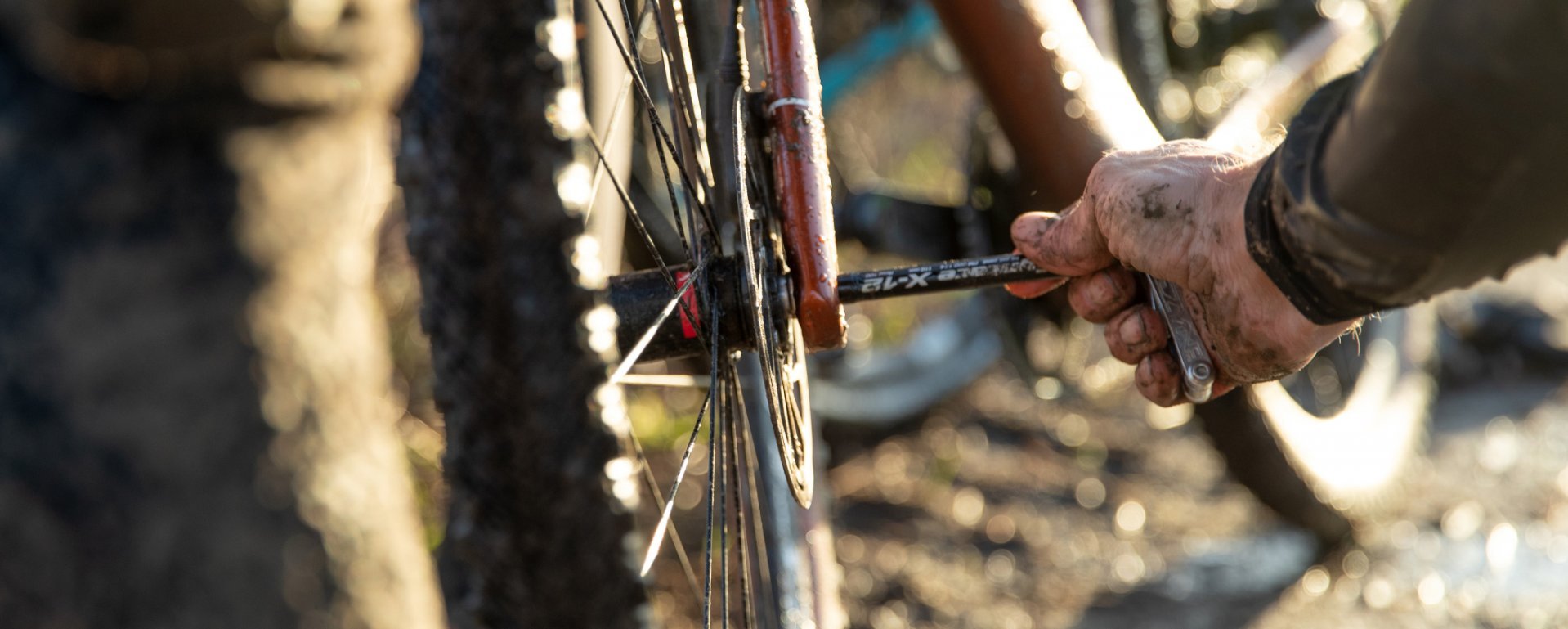
Gravel wheels must be able to withstand a lot of rough use. After all, the least-bouncy wheels feel comfortable even at high speeds and on rough surfaces. When it comes to the number of spokes, you can look with confidence towards XC mountain bikes and go for 28 or 32 spokes. The weight disadvantage compared to 24 spokes is negligible, but the stability is higher. For aerodynamic reasons, there is also a lot to be said for using bladed spokes – unless of course you’re an adventurer on a world tour. This is because bladed spokes are at a disadvantage compared to classic round spokes when it comes to performing roadside repairs and finding spare parts.
Gravel bikes like to be ridden in the dirt all year round – the name really says it all. With a well-sealed and robust hub, like the ones used for mountain bikes, you’re sure to be on the safe side. In addition, the selection of thru-axle hubs found under the MTB category is still higher than what you can find for road bikes. Choices can range from all-round classics such as the DT Swiss 240 or 240s as well as more MTB-typical names in the style of a Chris King Iso or Hope Pro 4. If you are more of a powerhouse with legs like Marcel Kittel, however, you should be careful not to go for the hub/freehub combinations with very fine gearing that are popular among mountain bikers. Your 1,000 watts of maximum power simply cries out for more generously-dimensioned pawls or sprockets, and the advantage of a small-angled engagement is also significantly less on a gravel bike than on an MTB. Regarding the front wheel hub, you should ask yourself – aside from compatibility and dimensions – one question in particular: front light or nah?
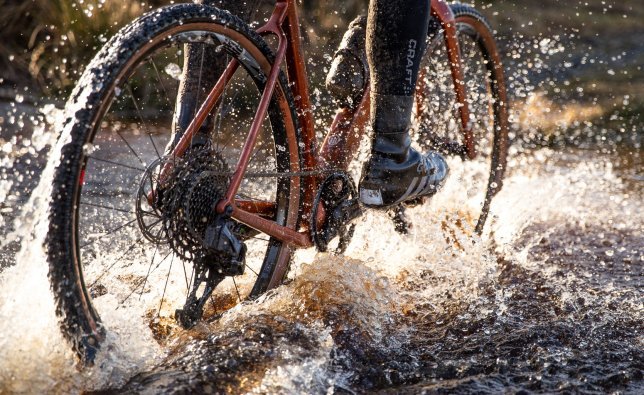
Gravel bikes, as mentioned, are excellent long-distance or adventure bikes. Whether it's long laps across a variety of surfaces in the unknown back country or epic bikepacking adventures, having lights is a must here, as is a high degree of stability and easy reparability. The former can be provided by a modern hub dynamo, which, in conjunction with a charger such as the Plug5 Pure from cinq or the E-Werk from Busch & Müller, can also charge other devices such as a GPS or smartphone. The latter can be achieved primarily by using components that are as sturdy and widely-available as possible. Since adventure bikers often bear heavy loads, there is a lot to be said for 32 classic round spokes in combination with a well-sealed rear hub and robust alloy rims. Spare parts for these items are available almost everywhere worldwide. Everyday cyclists who enjoy the sportiness of a gravel bike during the week and who use it for training or touring on weekends appreciate the same advantages. Remember: you should not underestimate the value in everyday use in terms of material wear. During winter in particular, road salt and dirt can take a significant toll on the hubs.
Are you now inspired to build your own gravel wheelset? Find more background in our guide, "The basics of custom wheel building".
